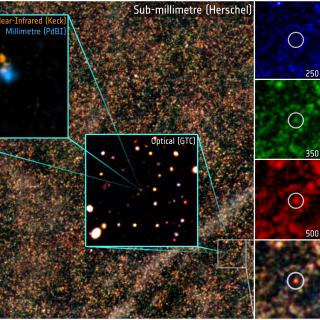Bibcode
Lupu, R. E.; Scott, K. S.; Aguirre, J. E.; Aretxaga, I.; Auld, R.; Barton, E.; Beelen, A.; Bertoldi, F.; Bock, J. J.; Bonfield, D.; Bradford, C. M.; Buttiglione, S.; Cava, A.; Clements, D. L.; Cooke, J.; Cooray, A.; Dannerbauer, H.; Dariush, A.; De Zotti, G.; Dunne, L.; Dye, S.; Eales, S.; Frayer, D.; Fritz, J.; Glenn, J.; Hughes, D. H.; Ibar, E.; Ivison, R. J.; Jarvis, M. J.; Kamenetzky, J.; Kim, S.; Lagache, G.; Leeuw, L.; Maddox, S.; Maloney, P. R.; Matsuhara, H.; Murphy, E. J.; Naylor, B. J.; Negrello, M.; Nguyen, H.; Omont, A.; Pascale, E.; Pohlen, M.; Rigby, E.; Rodighiero, G.; Serjeant, S.; Smith, D.; Temi, P.; Thompson, M.; Valtchanov, I.; Verma, A.; Vieira, J. D.; Zmuidzinas, J.
Referencia bibliográfica
The Astrophysical Journal, Volume 757, Issue 2, article id. 135 (2012).
Fecha de publicación:
10
2012
Revista
Número de citas
88
Número de citas referidas
76
Descripción
We present new observations from Z-Spec, a broadband 185-305 GHz
spectrometer, of five submillimeter bright lensed sources selected from
the Herschel-Astrophysical Terahertz Large Area Survey science
demonstration phase catalog. We construct a redshift-finding algorithm
using combinations of the signal to noise of all the lines falling in
the Z-Spec bandpass to determine redshifts with high confidence, even in
cases where the signal to noise in individual lines is low. We measure
the dust continuum in all sources and secure CO redshifts for four out
of five (z ~ 1.5-3). In one source, SDP.17, we tentatively identify two
independent redshifts and a water line, confirmed at z = 2.308. Our
sources have properties characteristic of dusty starburst galaxies, with
magnification-corrected star formation rates of 102 - 3
M &sun; yr-1. Lower limits for the dust
masses (~ a few 108 M &sun;) and spatial extents
(~1 kpc equivalent radius) are derived from the continuum spectral
energy distributions, corresponding to dust temperatures between 54 and
69 K. In the local thermodynamic equilibrium (LTE) approximation, we
derive relatively low CO excitation temperatures (lsim 100 K) and
optical depths (τ <~ 1). Performing a non-LTE excitation analysis
using RADEX, we find that the CO lines measured by Z-Spec (from J = 4
→ 3 to 10 → 9, depending on the galaxy) localize the best
solutions to either a high-temperature/low-density region or a
low/temperature/high-density region near the LTE solution, with the
optical depth varying accordingly. Observations of additional CO lines,
CO(1-0) in particular, are needed to constrain the non-LTE models.
Proyectos relacionados

Formación y Evolución de Galaxias: Observaciones Infrarrojas y en otras Longitudes de Onda
Este grupo desarrolla varios proyectos extragalácticos en diferentes rangos del espectro electromagnético utilizando satélites y telescopios en tierra para estudiar la evolución cosmológica de las galaxias y el origen de la actividad nuclear en galaxias activas. En el aspecto instrumental, el grupo forma parte del consorcio internacional que ha
Ismael
Pérez Fournon